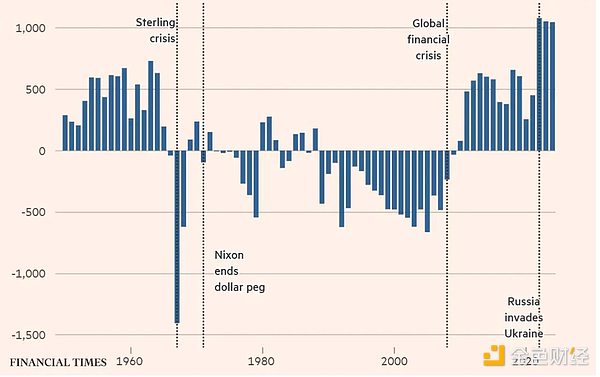Author: Matt Hougan, Chief Investment Officer of Bitwise; Translator: AIMan@Golden Finance
The world is beginning to realize the madness of the fiat currency experiment.
Legendary author David Foster Wallace opened his 2005 commencement speech at Kenyon College with a parable:
Two little fish were swimming and happened to meet a big fish swimming in the opposite direction. The big fish nodded to them and said, "Good morning, kids. How's the water?" The two little fish swam for a while, and finally one of them looked at the other and asked, "What the hell is water?"
Wallace's point is that we often turn a blind eye to the most important realities, especially when these realities have surrounded our entire lives.
I've been thinking about those fish lately.
Like nearly every other financial professional these days, I have lived my entire life in a fiat-based world—one in which a country’s money supply is not based on its accumulation of reserves like gold or silver, but is determined by the government. The United States left the gold standard 54 years ago, in 1971. Assuming most people start their careers at age 21, today the youngest person in finance who remembers working in an era without fiat money is probably 75.
When most of us were in school, the adoption of fiat money was seen as an inevitable progression, like crawling out of the mud and starting to walk upright.
People in the past thought gold was money, and we laughed. How cute.
But there seems to be a growing awareness that this fiat era we are living through may be an exception. Maybe it’s a crazy idea to print money out of thin air, as we began to do in 1971.
Perhaps sound money needs limits.
In other words, people are starting to look around and ask: what exactly is fiat money?
One group asking this question was the Financial Times in August, whose “big read” last weekend was a deep dive into how gold has become a safe haven from the world’s uncertainty.
One key passage:
For the guardians of the global economy, gold – a store of value since the first bar was struck in Mesopotamia thousands of years ago – seems destined to become irrelevant.
Yet gold bullion has made a strong comeback, favored not only by speculators and so-called “gold bugs” who distrust modern paper money, but even by the world’s most conservative investors…
In politically feverish times, when many core assumptions about the global economy are being questioned, gold is once again a pillar of support.
The Financial Times notes that central banks – who were regular buyers of gold before 1971 – are now buying gold in large numbers again. As the chart below shows, these annual purchases began after the 2008 financial crisis and went into overdrive in 2020 after Russia’s invasion of Ukraine. In other words, these purchases began when central banks began to really abuse fiat currencies, and accelerated once governments began to seize some of their fiat currencies.
Central banks are pouring record amounts into gold buying
Central bank net purchases/sales (tonnes of gold bars)

Source: Financial Times, data from Metals Focus, Refinitiv GFMS and World Gold Council.
Note: Chart shows net demand (i.e., gross purchases less gross sales) by central banks and other official institutions, including supranational entities like the IMF. Excludes the impact of swaps and delta hedging.
Last year, gold surpassed the euro to become the world’s second-largest reserve asset after the dollar. With the U.S. debt approaching $37 trillion and the temptation to devalue the dollar to get out of trouble growing, central bankers realize they need to hedge their risk. They want a currency that is:
* Scarce
* Global
* Hard for governments to manipulate
* Can be held directly in a sovereign manner.
You get the idea. These qualities don’t just apply to gold.
They’re increasingly looking at Bitcoin.
Bitcoin: The antidote to fiat currency debasement
Like governments, individual investors are beginning to wake up to the dangers of reckless money printing. But interestingly, they’re mostly doing it as a hedge with Bitcoin — widely considered a digital alternative to gold. Since launching in January 2024, Bitcoin ETFs have attracted $45 billion in inflows, compared to $34 billion for gold ETFs over the same period.
Why the difference between governments and regular folks? The main reason is capacity: At $2 trillion, Bitcoin’s market is still too small for central bankers to invest in, and its liquidity isn’t enough to support large-scale central bank inflows and outflows. I suspect this will change over time — in fact, government demand for Bitcoin will only grow. But for now, I think these are two sides of the same trade.
Whether we’re talking about gold or Bitcoin, however, the basic point is the same: For the past four decades, we’ve been taught to diversify our portfolios with a mix of stocks and bonds. But no matter how you tweak it — 60% stocks, 40% bonds, or 70%/30, whatever — you’re still 100% invested in fiat.
People realize that swimming in these waters is pretty dangerous.
 Weatherly
Weatherly




